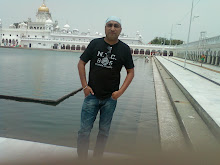MARTYRDOM OF THE TWO ELDER SAHIBZADAS
AJIT SINGH AND JUJHAR SINGH
Sahibzada Ajit Singh, the eldest son of Guru Gobind Singh, was born to Mata Sundri at Paonta on 26 January 1687. The following year the Guru and his family returned to Anandpur. Sahibzada Jujhar Singh, the second son of Guru Gobind Singh, was born to Mata Jito-ji at Anandpur on 14 March 1691. From a very young age both brothers were taught the religious texts, philosophy and history alongside their training in swordsmanship, archery and horse riding. Soon they grew up into handsome young men, strong, intelligent and natural leaders of men. In 1699 both Sahibzade Ajit Singh and Jujhar Singh, 12 years and 8 years of age respectively, received the rites of Khalsa initiation.
Soon after the creation of Khalsa on 30 March 1699, Ajit Singh had his first test of skill. A Sikh Sangat coming from Pothohar was attacked and looted by Ranghars on the way, a short distance from Anandpur across the River Sutlej. Guru Gobind Singh sent Sahibzada Ajit Singh, then barely 12 years of age, at the head of about 100 Sikhs to punish the Ranghars and to recover the loot. The following year, 29 August 1700, when the hill Rajas, backed by Imperial troops, attacked Anadpur. Ajit Singh was made responsible for the defence of Taragarh Fort which became the first target of attack. Ajit Singh, assisted by Bhai Ude Singh, a seasoned soldier, repulsed the attack. On 15 March 1701 a column of Sikh devotees coming from Darap area (present Sialkot district) was waylaid by Gujjars and Ranghars. Sahibzada Ajit Singh led a successful expedition against them. Instructed by his father, on 7 March 1703, he took out 100 horsemen to Bassi, near Hoshiarpur and rescued a young Brahman bride forcibly taken away by the local Pathans.
During the prolonged siege of Anandpur, it became necessary to leave the city under the pressure of pursuing enemy. Both the Sahibzade were experienced warriors, strong and fearless, displaying qualities of courage and steadfastness. On the night of 5 December 1705 Guru Gobind Singh gave each of his sons the command of a band of brave Sikhs to wade through the flooded Sarsa river on horseback and head towards the Fort of Chamkaur. Amidst the fierce fighting in the darkness of night and the hazardous long journey the Guru and the Sikhs, together with his family and both the elder Sahibzade in command of their bands, made their way to Chamkaur. Further reduced in numbers by casualties at the hands of the enemy they reached Chamkaur by nightfall on 6 December 1705 and took up position in the Garhi - high walled fortified house. The enemy, with extra reinforcements from Malerkotla and Sirhind and from among local Ranghars and Gujjars, threw a tight ring around the fort of Chamkaur.
An unequal but grim battle commenced with the dawn of 7 December 1705 - in the words of Guru Gobind Singh’s Zafarnama --- ‘a mere forty defying a million’. The Sikhs, after they had exhausted the meagre stock of ammunition and arrows, made sallies in batches of five to engage the encircling enemy with sword and spear. Sahibzada Ajit Singh led one of the sallies and laid down his life fighting in the bloody battle, followed by his younger brother Sahibzada Jujhar Singh who led the next sally. Sahibzada Ajit Singh and Sahibzada Jujhar Singh, 18 and 14 years old respectively, who like the other brave Sikhs, fell fighting heroically. The valour displayed by the young sons of Guru Gobind Singh has been sympathetically and vividly narrated in the poems of a devout Muslim, Allahyar Khan Jogi.
Today Gurdwara Qatalgarh Sahib (Shahid Ganj) is the main shrine at Chamkaur. This marks the site where the most fierce hand-to-hand combat took place on 7 December 1705 between the Mughal army and a handful of brave Sikhs, including Sahibzade Ajit Singh and Jujhar Singh, and three of the original Panj Piare (Guru’s Five Beloved ones).
Unfortunately, during the crossing of the flooded river Sarsa, Mata Gujri and the two younger Sahibzade Zorawar Singh and Fateh Singh, aged 9 and 7 years respectively, together with their cook, Gangu, were separated from the Guru and the Sikhs. Seizing the opportunity of a reward Gangu spied on them and handed them over to the enemy. Both the young Sahibzade were executed on 12 December 1705 in Sirhind.
The four young princes of genteel birth - The Char Sahibzade - is the term endearingly used for the four sons of Guru Gobind Singh, all of whom died as martyrs while still in their tender age. Their names are reverently preserved in Sikh memory and are recalled every time the Sikh Ardas or prayer of supplication is recited at every religious ceremony in a congregation and privately twice a day (after the morning and evening prayer) by an individual.
Sahibzada Ajit Singh - born on 26 January 1687 at Paonta Sahib
Father Guru Gobind Singh Ji, Mother Mata Sundri Ji
Sahibzada Jujhar Singh - born on 14 March 1691 at Anandpur Sahib
Father Guru Gobind Singh Ji, Mother Mata Jito-Ji
Sahibzada Zorawar Singh - born on 17 November 1696 at Anandpur Sahib
Father Guru Gobind Singh Ji, Mother Mata Jito-Ji
Sahibzada Fateh Singh - born on 25 February 1699 at Anandpur Sahib
Father Guru Gobind Singh Ji, Mother Mata Jito-Ji
Bhullan Chukan Di Khima.
